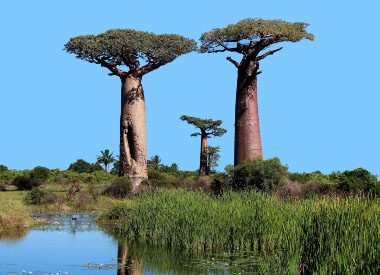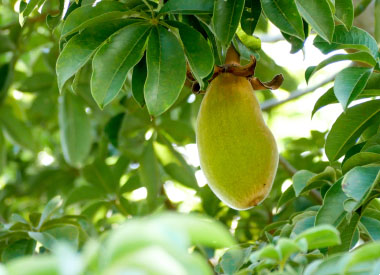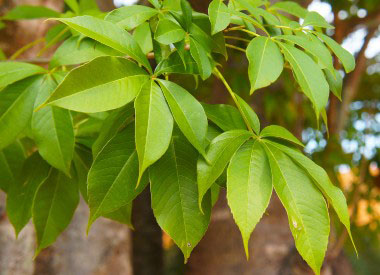






To support our efforts please browse our store (books with medicinal info, etc.).
Baobab is a large, round canopied tree with a swollen trunk, often with a bole of 3 to 10 metres (9 to 30'). In fact, there are some trees that can attain a girth of up to 28 metres (90'), sometimes exceeding the width of the canopy. Adansonia digitata is in the Malvaceae family and is native to Subsaharan Africa. The species is also known as the upside down tree because its stretching canopy resembles a root system. The tree is characteristic of thorn woodlands of the African savannahs. Interestingly, they are resistant to fire, termites and drought. Even if the interior is completely burnt out, the tree continues to live. Regrowth after fire produces a thickened, uneven integument giving the tree a gnarled appearance but this serves as added protection against fire. The baobab is said to be the longest-living flowering tree on Earth with the ability to possibly live up to 4,000 years. In Senegal the baobab is very important for the country, hence it is even displayed in the coat of arms. The genus name Adansonia honors Michel Adanson (1727-1806), French botanist and naturalist.
Trunk/Bark
The surface of mature bark is soft to the touch, grayish brown or reddish brown, sometimes purplish-grey. The bark of leaf-bearing branches is normally ashy on the last node.
Branches/Twigs
The sparse, open canopy is made up of stout, upright branches.
Height
This tree grows anywhere from 10 to 25 metres (30 to 80') in height.
Leaves/Needles
The leaves are alternate, palmate, and typically grow 15 to 20cm (6-8") wide. Each palmate leaf has 5 to 7 leaflets and are dropped during the dry season. Leaflets are dark green, with short, soft hairs; lateral veins looping; with both the apex and base tapering. Margins are entire.
Flowers
The first rains of the wet season typically trigger flowering. Waxy, whitish flowers are produced having a diametre of up to 20cm (8"). Flowers are axillary and solitary. The calyx is deeply lobed, with white, silky hairs inside. The large, crinkly, spreading petals have stamens on a large central column that are shed with the petals. These unique flowers have a very unpleasant scent yet are beautiful to look at. They bloom late afternoon and remain in bloom for only about 24 hours. Mostly bats pollinate these flowers.
Fruit
The mature fruit is ovoid reaching lengths of up to 30cm (12"). It has has a hard, woody shell, covered with yellowish-grey velvety hairs. The seeds are smooth, embedded in a whitish powdery pulp. Baobab fruits are hailed as a superood rich in vitamin C, antioxidants, calcium, potassium and fiber.
Habitat
Baobab occurs as isolated individuals or grouped in clumps irrespective of soil type. Baobabs are not found in areas of deep sand, presumably because they are unable to obtain sufficient anchorage and moisture. Baobab is very sensitive to waterlogging and frost and it prefers a high watertable. These trees grow in Africa, parts of Asia and in Malaysia.
Edible Parts
The fruit is edible and can be made into a beverage. Ripe fruits are collected and cracked to remove the ‘flour’, which is mixed with milk to prepare a flavoured fermented porridge. Young leaves are also rich in Vitamin C and are high in demand in West Africa as a vegetable. The leaves also are used to make a condiment and seasoning.The small stem and roots of the seedlings are eaten as vegetable and mature, thick roots are cooked and eaten during famine. Having a high water content, the wood is chewed by humans and animals in case of extreme water scarcity.
Other Name
African Monkey Bread Tree.
Recipes
Winter Survival Food Handbook

PDF Plant Magazines
Types of Wild Food
Geographic Zones Seasons
Disclaimer
EdibleWildFood.com is informational in nature. While we strive to be 100% accurate, it is solely up to the reader to ensure proper plant identification. Some wild plants are poisonous or can have serious adverse health effects.
We are not health professionals, medical doctors, nor are we nutritionists. It is up to the reader to verify nutritional information and health benefits with qualified professionals for all edible plants listed in this web site. Please click here for more information.
Why Edible Wild Food?
- Food costs are rising
- Free, wild food is readily abundant
- Wild food adds nutrition to your diet
- Wild food can help treat various medical conditions





